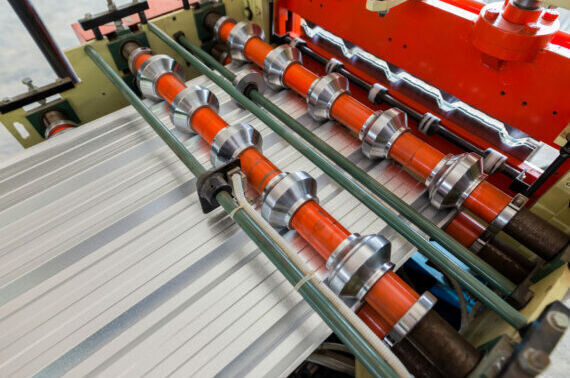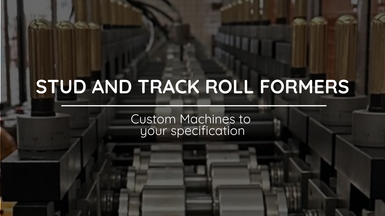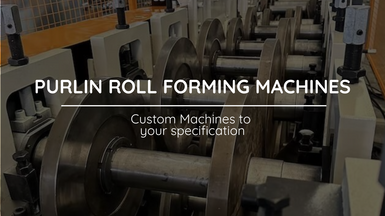
How to assemble a roll-forming machine
Proper setup of your roll-forming machine, combined with excellent employee training procedures, will ensure that you are set up for success.
Posted on Monday, November 28, 2022
The first step to take is to ensure that you understand the industry jargon. Getting to grips with the terminology used will help ensure that everyone speaks the same language and make the assembly process much more manageable.
To set up a roll form line, the operator will start by running a test line and discovering the result out of tolerance. From this, the line can be tweaked and retested until the measurements are as precise as they should be.
The initial setup can take time, mainly if tolerance requirements are tight. Material problems such as crossbow, snakes, center buckling, oil canning, and dishing can also cause problems and delays in the assembly process. However, good leveling will help to ensure that such issues are kept to a minimum. By purchasing high-quality material from reputable sellers, consistency can be much improved.
Following best roll-forming practices will also help ensure the set up goes smoothly. Best practices should be documented to ensure that all operators follow a standard procedure and are trained similarly.
The roll forming şet up process - how to begin
Labeling and organizing tools and spacers logically and near the machine from the outset will help to ensure the roll-forming operation runs as efficiently as possible. This way, any operator can read the setup sheet and find the tools they need with ease.
Before inserting any tools, shafts and machine face alignment spacers should be thoroughly cleaned to help ensure that the machine works as it should. Operators should then find out the location for the first pass and insert the tools accordingly, i.e., a spacer, then a roll, then a spacer. Ensure the stamped ring faces you when installing the first pass and that the numbers follow on sequentially for the job.
After placing the first station tools, the outboard stand can be placed onto the spindles and the shaft locking nuts secured. The inner race must be tightened, so it does not twist or run against the outboard stand before locking the outboard stand down with clamps or screws.
Next, measure the thickness of the materials you plan to insert into the roll-forming machine. Once you have determined the thickness, use the feeler gauge to preset the toll tooling gap on both the inboard and outboard sides. You can change the distance between the upper and lower shafts - doing so checks there is enough clearance for the material to roll through smoothly.
Measure the distance between the top and bottom roll flange and record this to use a baseline setup. Do this on the inboard and outboard side for every pass of roll form tooling.
After completing the above, the operator can run the material through the roll pass and reset the rolls according to their needs. It is essential to re-gap the rolls once the material has been loaded into the machine, as it can push the top rolls away from the bottom rolls after insertion, thus changing the gap distance.
Machine maintenance is another crucial part of roll-forming machine setup and care. Checking the roll stand adjustment screws are clean and free of debris, for example should be done regularly.
If a part comes out of the machine and is not in line with the specifications, you will need to ascertain and isolate the problem as quickly as possible. Checking the mill face and machine face alignment with a straight edge can determine whether the roll former is correctly aligned and help you discover the problem. If the alignment looks correct, inspect the strip as it emerges from each pass to check for errors at each stage. If the problem can be attributed to a specific pass, this can help to rectify it more swiftly.
Ensuring your machine is properly aligned is key to assembling your roll-forming machine correctly. A misaligned machine will deform the product shape and can cost you time and money. So taking the time to build your machine with care, recording measurements, and documenting processes from the outset will help keep your productivity and your business running smoothly.
If you are looking for a high-quality roll-forming machine to help boost your business, browse the range from roll-forming LLC today.
Roll Forming Machines LLC's New Factory
Posted on Sunday, March 23, 2025
We have relocated factories, which will be available for tours very soon.

Uncoiler, Decoiler and Coil Car Roll Forming Machine Accesories from Roll Forming Machines LLC
Posted on Sunday, November 24, 2024
Contact us today with your specifications for a custom Uncoiler, Decoiler or Coil Car at [email protected] or call us at (+1) (407) 859 1119

Stud and Track Roll Forming Machines from Roll Forming Machines LLC
Posted on Saturday, November 23, 2024
Contact us today with your specifications for a custom Stud and Track Machine at [email protected] or call us at (+1) (407) 859 1119

Cee and Zee Purlin Roll Forming Machines from Roll Forming Machines LLC
Posted on Saturday, November 23, 2024
Contact us today with your specifications for a custom Cee and Zee Purlin Machine at [email protected] or call us at (+1) (407) 859 1119